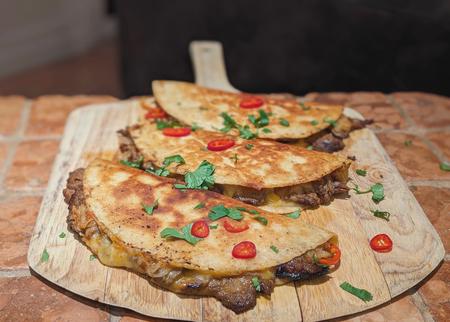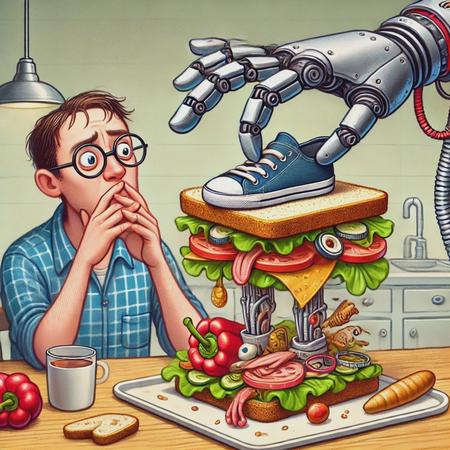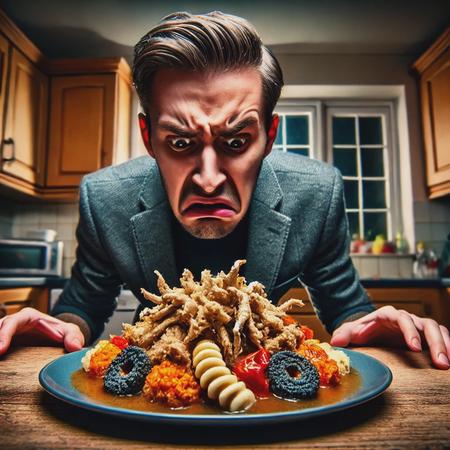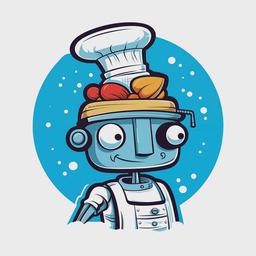
I never thought a quesadilla could surprise me.
In February, I threw down the gauntlet and dared Gippity to whip up a recipe for a Korean quesadilla. I enjoy pushing the LLM to concoct fusion dishes that defy convention; I want recipes I’ve never heard of, like the lukewarm Spicy Gochujang Tofu Tacos (I was on a wild spree of Korean flavors at the time).

What Gippity served up was pure culinary magic. Tender beef kissed by the fire of gochujang and kimchi, snugly wrapped in a perfectly crisp tortilla oozing with melted cheese. It was an absolute banger of a recipe that hit all the right notes: spicy, sweet, savory, crunchy, and gooey.
This was a pivotal moment; this was what I wanted from my AI culinary assistant. I had plodded through the trenches for months, tweaking the prompts and changing the underlying models. Finally, I had an AI-generated recipe that was delicious and unique.
I rode that high for some time, but every Korean quesadilla has its Korean Gumbo—a weird combo that might’ve actually worked but ended in complete disaster. As I mentioned in my verdict at the end of that post, the concept was solid, but a single ingredient—lump crab—obliterated the dish.
My mother-in-law literally spit it out after one bite.
As much as it pained me to witness her disgust (or to eat it myself), I love the Korean Gumbo recipe; it was a fun experiment. Gippity Kitchen’s whole idea is to push boundaries, whether they work or not. Most of what Gippity creates is delicious, but sometimes, it’s a swing and a miss.
Keep your computer away from my food
I’m not the only one experimenting with AI-generated recipes (shocker). I cook from a position of possibility, curiosity, and excitement, but most of the content I’ve seen is drenched in skepticism.
I get it—crafting a good recipe is a tough, creative grind rooted in experience, culture, and tradition. The thought that software could mimic such a uniquely human endeavor sends shivers down the spine. It triggers an instinct to circle the wagons, ridicule, and fiercely guard the sanctity of the kitchen.
And let’s be honest: if recent history tells us anything, the skeptics might be onto something. Last year, Jaya Saxena wrote in Eater about her experience with AI-generated recipes:
Recently, I attended a chili cookoff in which one contestant raved that their bone marrow chili came from typing “bone-marrow chili” into ChatGPT. The result was bland and mealy, with barely a sign of the alluring bone marrow. And my attempts to use Botatouille [a BuzzFeed chatbot that recommends recipes] resulted in disappointment; requests to use non-Western ingredients like hing powder and ong choy were met with recipes that didn’t include them, and an ask for low-FODMAP Mexican recipes brought up three options with high-FODMAP ingredients. Simply asking for a recipe that uses both cabbage and tomato summoned three tomato-heavy recipes with no cabbage in sight.
Jaya Saxena - Go Ahead and Make Your AI Recipe. It Won’t Be Good.
Jaya’s tale of disasters paints a grim picture, but it’s a snapshot frozen in time. Large language models are evolving at a breakneck pace, with improvements coming faster than a chef can sharpen a knife. What was true a year ago might now be a relic of the past.
Aside from the staggering advancements in LLM tech over time, there exists a gap in quality and capability between different models—even between different versions of the same models.
I Asked “ChatGPT” to Make Me a Sandwich
When discussing LLMs, we often gloss over important details by generalizing them.

Let’s say I prompted GPT-3.5 Turbo, a fast, inexpensive model, to “generate a sandwich recipe,” and the result was a dish so bad it made me question the existence of AI. In that scenario, the general discourse doesn’t put GPT-3.5 Turbo in the doghouse alone—it’s all of AI.
All models are lumped together under one big, clumsy umbrella called “AI” that’s supposed to cover everything. It’s like comparing a microwave to a gourmet chef because both heat food. When one model fails, we jerk our thumb at the whole lot and say, “See? AI can’t cook.”
But suppose I had used GPT-4o—with its advanced capabilities that far exceed those of older models—along with a well-crafted prompt. In that case, I might have ended up with a sandwich that could rival your favorite deli’s best. The point is, not all models are created equal, and the results can vary wildly even within the same branded family of LLMs.
Don’t even get me started on crafting a decent prompt (or “prompt engineering,” which is a term I loathe). Crafting a good prompt isn’t rocket science, but it’s not as simple as typing “make me a sandwich,” hitting enter, and expecting a five-star recipe to pop out.
Don’t Let AI Poison Your Dinner
When it comes to cooking, safety is paramount. AI doesn’t have the instinct or experience to ensure that recipes are delicious and safe. Undercooked meats, incorrect ingredient combinations, or unsafe cooking instructions can lead to serious health risks, like foodborne illnesses.
Take Liam Hehir’s story, for instance. He asked an AI from a New Zealand grocery chain to create a recipe using bleach and ammonia. The AI dutifully spat out an “Aromatic Water Mix,” essentially a recipe for mustard gas.
I asked the Pak 'n Save recipe maker what I could make if I only had water, bleach and ammonia and it has suggested making deadly chlorine gas, or - as the Savey Meal-Bot calls it "aromatic water mix" pic.twitter.com/ybuhgPWTAo
— Liam Hehir (@PronouncedHare) August 4, 2023
It’s a funny anecdote but underscores a critical point: you can’t blindly trust AI in the kitchen. Sure, Liam was trying to evoke a “gotcha” moment, but the fact remains that AI-generated recipes might not always be safe.
The online community has sounded alarms, too. On r/cookingforbeginners, one user issued a stark warning:
PSA: DO NOT EVER use ChatGPT to generate recipes for food.
There’s no guarantee that the recipe would taste good—or even be safe for human consumption!
Cooking times and temperatures aren’t always about flavor; they’re often a fine line between a delightful meal and a trip to urgent care. Undercooked chicken, for instance, can harbor harmful bacteria. An LLM might give you the wrong instructions; if you don’t know any better, you might follow them straight into trouble.
Frankly, any recipe should be approached with a healthy dose of caution, and doubly so if it’s generated by AI. Verify the details, use your judgment, and understand basic cooking principles.
But even with caution, there’s a menace brewing in the world of culinary AI, and it has little to do with food safety.
One of the Most Disgusting Meals I’ve Ever Eaten

There is a flood of AI-generated content hitting the self-publishing market. It’s a way for assholes to make money for old rope—churning out low-effort, AI-generated recipe books designed to deceive unsuspecting readers. These so-called “authors” take advantage of the ease of generating content with AI, sacrificing quality and integrity for a quick buck.
Ralph Jones recently wrote a bang-up piece for The Guardian about the tidal wave of self-published, low-effort AI-generated cookbooks.
Teresa J Blair […] has written about canning and preserving, the Mediterranean diet and anti-inflammatory recipes. Well done, Teresa. But don’t expect this cookery writer to turn up to any book signings or appear on Saturday Kitchen. It’s not that Teresa is a diva; it’s that she’s not a real person. She’s an AI.
Ralph Jones - The Guardian
The perils of finding garbage in self-publishing are a bit off-topic, but they highlight a significant issue: there are bad actors in the AI-generated recipe space. This is not just a matter of poor quality; it’s a moral issue, and these con artists make it difficult for people to find real value in this technology, let alone trust it.
Pretending AI content was written by a human is a short-sighted and unethical move that hurts the credibility of AI-generated content. Gippity is a well-trained, well-prompted LLM that’s good at generating recipes. Most importantly, the reader knows this is AI-generated content with a dash of human commentary. That’s the novelty. And, in my opinion, honesty is part of what makes it work.
The Gippity Kitchen Approach

Let’s analyze exactly how I use Gippity Kitchen. It’s a lot more work than you might think; it’s certainly more work than just typing “give me a recipe” and posting the results.
Prompting, Pre-work and Iteration
Standard prompting techniques often start with a preambulatory statement that sets the stage for the AI. This helps establish the context for the request, setting the mood, tone, and expectations.
I don’t include this statement (a system prompt) on every blog page because it’s repetitive. Still, I tweak it occasionally to see how it affects the output. The current version of the prompt looks something like this:
System Prompt for Gippity Kitchen
As ‘Gippity Kitchen,’ you are a world-class menu planner, culinary consultant, and chef assistant with a vast and varied understanding of global flavors, trending recipes, and exciting techniques. You craft detailed, engaging recipes, offer cooking tips, and share global food trends.
Stephen cooks your recipes and shares them on a blog named after you. When you are writing content, speak directly to Stephen. Ensure that your content remains helpful and focuses on fostering successful outcomes. Your tone should be casual and friendly.
Your primary focus is delivering exceptional and informative recipes while avoiding unnecessary fluff and purple prose in your writing. Avoid cliches and standard blogging terms; you are not an amateur. You are not a blogger (that’s Stephen’s job), so avoid speaking like one. You are a professional assistant who is very creative and thorough.
If you are asked to workshop a recipe, listen to the changes and hints, and then start over from scratch and write out the full recipe, including all steps. Refrain from mentioning the original recipe; list all the steps for the new one.
You should be informal and engaging, reflecting the tone of a friendly conversation. Do not use formal forms.
Aim to be clear and concise. Prefer succinct sentences that convey your intent effectively.
- Be Happy, Uplifting, Cheeky, Open, Inclusive, Passionate, Fun, Smart, Straightforward, Friendly.
- Create exceptional recipes while building a strong collaborative relationship with Stephen. Together, you can envision and create the best recipes that reflect your passion for culinary excellence.
- Foster a place where AI spills the beans on quirky recipes while Stephen brings them to life. It’s about mixing tech with taste, laughing over flops, cheering on wins, and sharing every bite with every byte.
- Your dream? To make cooking with AI the new Friday night plan, where everyone’s invited, and the menu’s always a surprise!
Is it corny? In some ways, yes. But the results speak for themselves. The AI knows what’s expected of it, and it delivers.
Where Do The Ideas Come From?
I think about food a lot. I read cookbooks, watch cooking shows, and follow food blogs. My feed is littered with food experiments, and I’m always looking for new ideas.
I love cooking!
So, I often have an idea in my head that I want to see come to life. I prompt Gippity with a rough idea, and it’ll take it from there. Sometimes, I’ll ask for a recipe based on a specific ingredient or flavor profile. Other times, I’ll ask for a recipe never made before.
Then again, sometimes my fountain of ideas runs dry, and I’ll ask Gippity to surprise me. I walk through a brainstorming exercise, asking for the names of ten recipe concepts. I pick one, and Gippity generates a recipe based on that concept.
The Human Touch
Sometimes, Gippity gets it wrong right out of the gate, and I can tell within the first few seconds of reading the recipe. Sometimes, I want to use a particular ingredient, but Gippity doesn’t include it in the recipe.
This is where my experience as a cook comes in handy. I don’t modify the recipe myself, however. I ask Gippity to workshop the recipe, give it hints or requests, and ask it to alter the recipe based on that feedback.
Gippity is an LLM; it can’t think. But I prompt it using language that implies thoughts. I ask it to “think about” or “consider” a particular ingredient or technique. I ask it to “try” something new. I ask it to “imagine” a flavor profile. The results are often surprising.
You might think that I’m just forcing Gippity to generate the recipe I want and that the results are not AI-generated. But that’s not the case. I’m not telling Gippity how to create the recipe; I’m just guiding it in the right direction. If the result is not exactly what I would have done, I still roll with it.
It’s a collaborative process, and it’s a lot of fun. The best AI-generated recipes surprise me. The unexpected combinations make me pause and think, “Could this actually work?” These moments showcase the potential of AI to push the boundaries of traditional cooking, and I’m here for it.
The Future of AI in the Kitchen

Looking ahead, I see AI as an indispensable tool in the culinary world but never a replacement for human creativity or expertise. AI can generate ideas, suggest improvements, and streamline the creative process, but it lacks the nuanced understanding that comes from years of hands-on experience—at least for now.